Analysing Organisational Behaviour at Tesco: Leadership & Motivation
VerifiedAdded on 2023/06/12
|32
|5806
|355
Report
AI Summary
This report provides a comprehensive analysis of organisational behaviour at Tesco, focusing on various aspects such as leadership, employee motivation, power dynamics, and company culture. It begins by assessing personality traits and attributes of managers and their impact on company performance, highlighting the importance of personality and perception in managerial relationships. The report then explores the application of content and process motivational theories to enhance employee productivity, specifically addressing issues like low morale and lack of focus. Furthermore, it examines the effects of power, politics, and culture on employee behaviour and organisational goal achievement, offering recommendations for improvement. The analysis uses models like Herzberg's Two-Factor Theory and Vroom's Expectancy Theory to provide practical insights into Tesco's human resource management strategies. This document, contributed by a student, is available on Desklib, a platform offering a wide range of study tools and solved assignments.
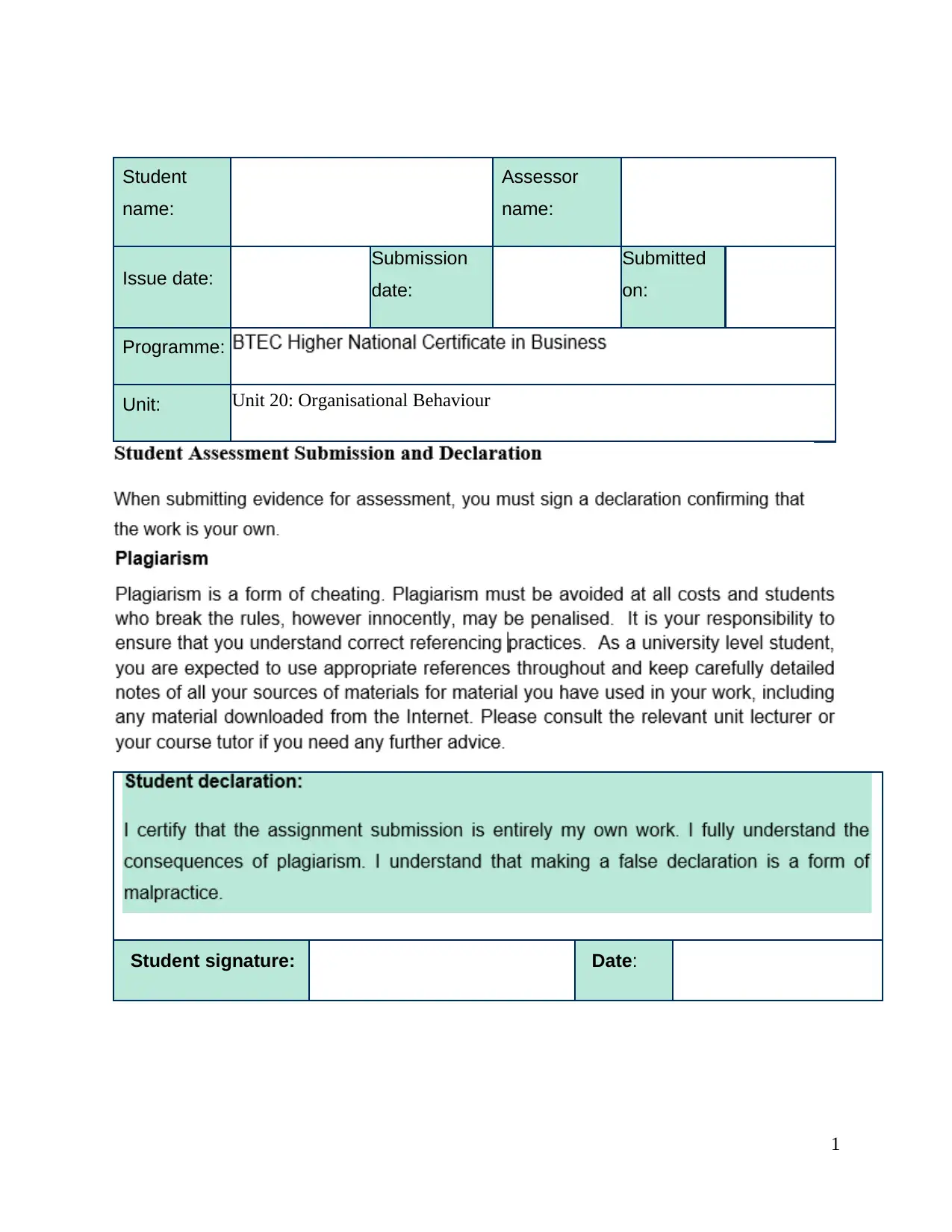
Student
name:
Assessor
name:
Issue date:
Submission
date:
Submitted
on:
Programme:
Unit: Unit 20: Organisational Behaviour
Student signature: Date:
1
name:
Assessor
name:
Issue date:
Submission
date:
Submitted
on:
Programme:
Unit: Unit 20: Organisational Behaviour
Student signature: Date:
1
Paraphrase This Document
Need a fresh take? Get an instant paraphrase of this document with our AI Paraphraser
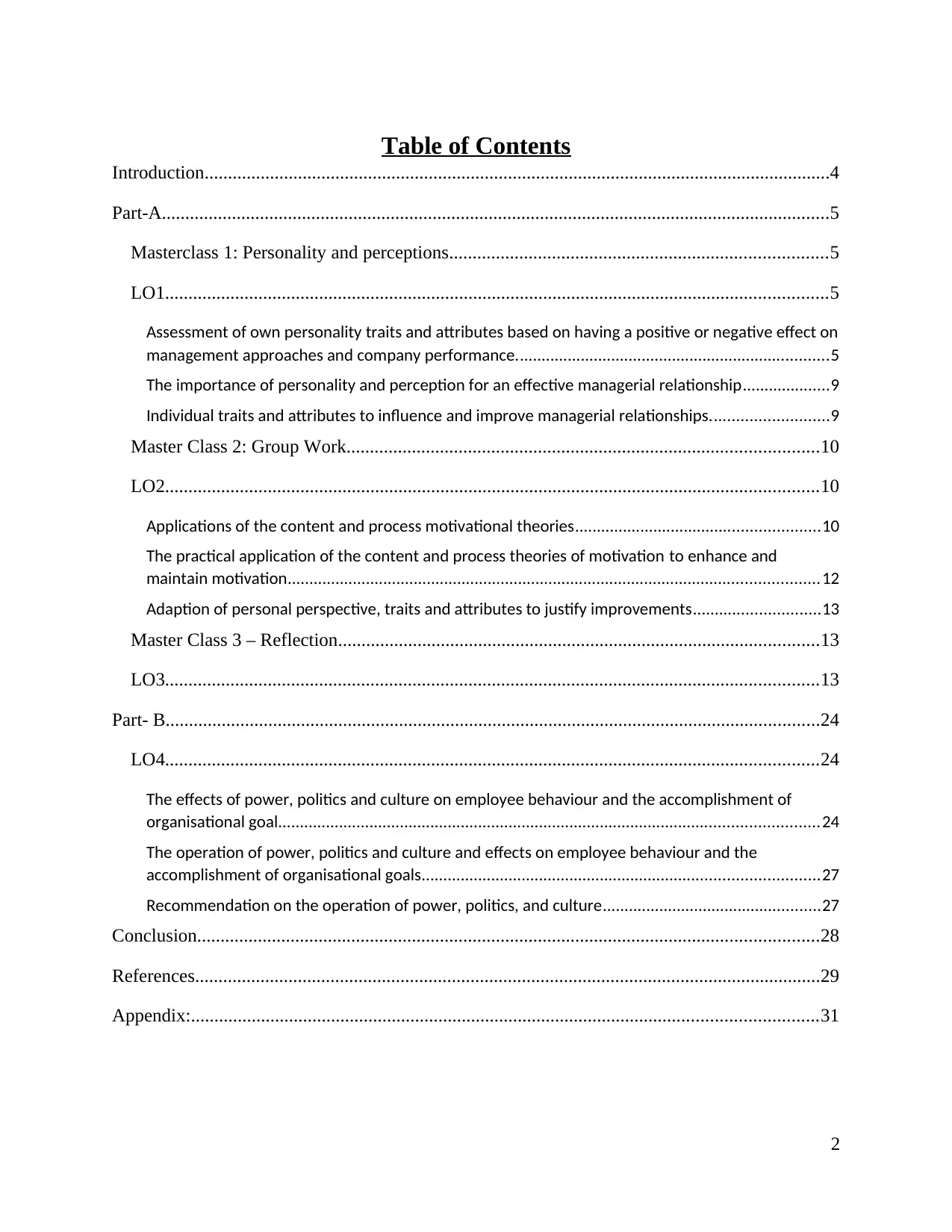
Table of Contents
Introduction......................................................................................................................................4
Part-A...............................................................................................................................................5
Masterclass 1: Personality and perceptions.................................................................................5
LO1..............................................................................................................................................5
Assessment of own personality traits and attributes based on having a positive or negative effect on
management approaches and company performance........................................................................5
The importance of personality and perception for an effective managerial relationship....................9
Individual traits and attributes to influence and improve managerial relationships...........................9
Master Class 2: Group Work.....................................................................................................10
LO2............................................................................................................................................10
Applications of the content and process motivational theories........................................................10
The practical application of the content and process theories of motivation to enhance and
maintain motivation..........................................................................................................................12
Adaption of personal perspective, traits and attributes to justify improvements.............................13
Master Class 3 – Reflection.......................................................................................................13
LO3............................................................................................................................................13
Part- B............................................................................................................................................24
LO4............................................................................................................................................24
The effects of power, politics and culture on employee behaviour and the accomplishment of
organisational goal............................................................................................................................24
The operation of power, politics and culture and effects on employee behaviour and the
accomplishment of organisational goals...........................................................................................27
Recommendation on the operation of power, politics, and culture..................................................27
Conclusion.....................................................................................................................................28
References......................................................................................................................................29
Appendix:......................................................................................................................................31
2
Introduction......................................................................................................................................4
Part-A...............................................................................................................................................5
Masterclass 1: Personality and perceptions.................................................................................5
LO1..............................................................................................................................................5
Assessment of own personality traits and attributes based on having a positive or negative effect on
management approaches and company performance........................................................................5
The importance of personality and perception for an effective managerial relationship....................9
Individual traits and attributes to influence and improve managerial relationships...........................9
Master Class 2: Group Work.....................................................................................................10
LO2............................................................................................................................................10
Applications of the content and process motivational theories........................................................10
The practical application of the content and process theories of motivation to enhance and
maintain motivation..........................................................................................................................12
Adaption of personal perspective, traits and attributes to justify improvements.............................13
Master Class 3 – Reflection.......................................................................................................13
LO3............................................................................................................................................13
Part- B............................................................................................................................................24
LO4............................................................................................................................................24
The effects of power, politics and culture on employee behaviour and the accomplishment of
organisational goal............................................................................................................................24
The operation of power, politics and culture and effects on employee behaviour and the
accomplishment of organisational goals...........................................................................................27
Recommendation on the operation of power, politics, and culture..................................................27
Conclusion.....................................................................................................................................28
References......................................................................................................................................29
Appendix:......................................................................................................................................31
2

3
⊘ This is a preview!⊘
Do you want full access?
Subscribe today to unlock all pages.

Trusted by 1+ million students worldwide
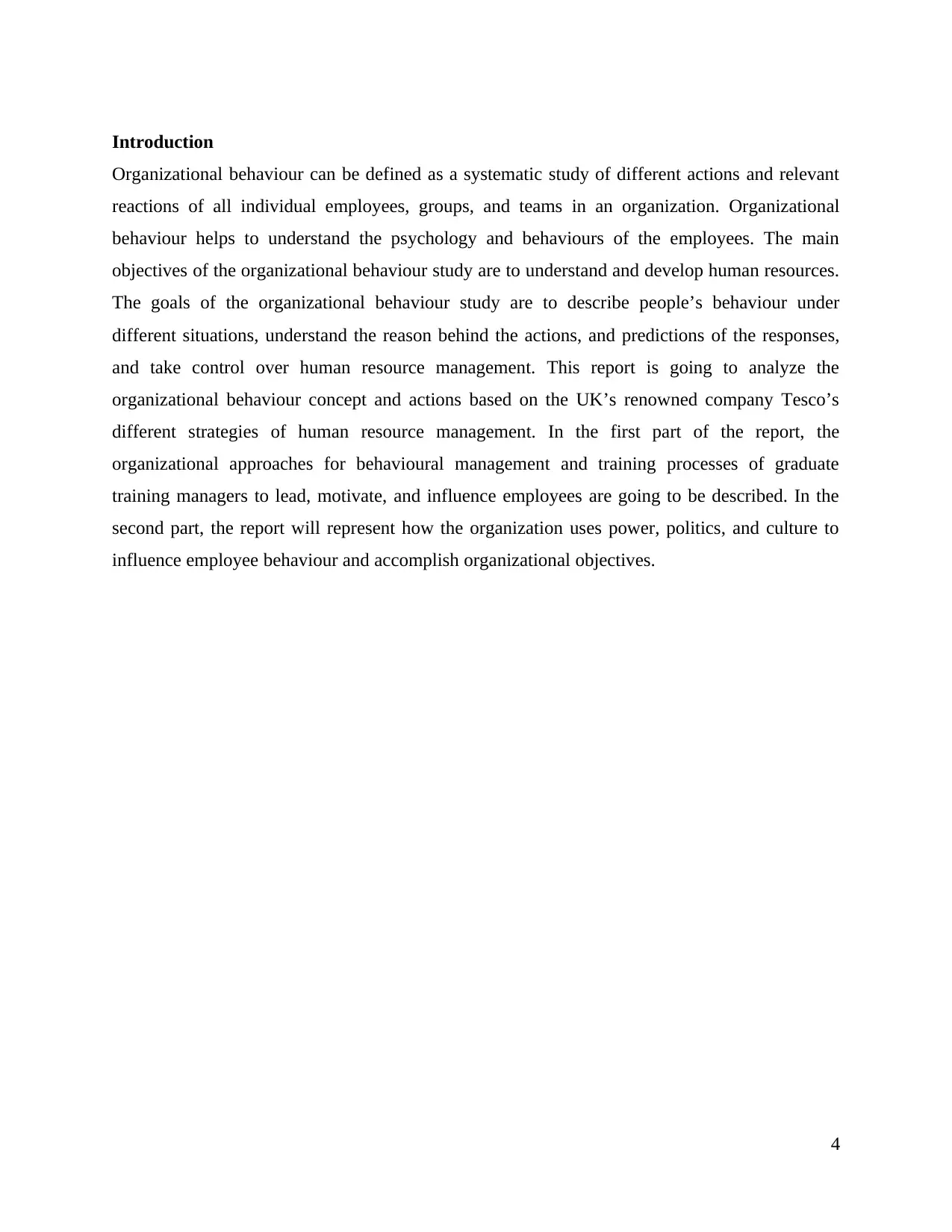
Introduction
Organizational behaviour can be defined as a systematic study of different actions and relevant
reactions of all individual employees, groups, and teams in an organization. Organizational
behaviour helps to understand the psychology and behaviours of the employees. The main
objectives of the organizational behaviour study are to understand and develop human resources.
The goals of the organizational behaviour study are to describe people’s behaviour under
different situations, understand the reason behind the actions, and predictions of the responses,
and take control over human resource management. This report is going to analyze the
organizational behaviour concept and actions based on the UK’s renowned company Tesco’s
different strategies of human resource management. In the first part of the report, the
organizational approaches for behavioural management and training processes of graduate
training managers to lead, motivate, and influence employees are going to be described. In the
second part, the report will represent how the organization uses power, politics, and culture to
influence employee behaviour and accomplish organizational objectives.
4
Organizational behaviour can be defined as a systematic study of different actions and relevant
reactions of all individual employees, groups, and teams in an organization. Organizational
behaviour helps to understand the psychology and behaviours of the employees. The main
objectives of the organizational behaviour study are to understand and develop human resources.
The goals of the organizational behaviour study are to describe people’s behaviour under
different situations, understand the reason behind the actions, and predictions of the responses,
and take control over human resource management. This report is going to analyze the
organizational behaviour concept and actions based on the UK’s renowned company Tesco’s
different strategies of human resource management. In the first part of the report, the
organizational approaches for behavioural management and training processes of graduate
training managers to lead, motivate, and influence employees are going to be described. In the
second part, the report will represent how the organization uses power, politics, and culture to
influence employee behaviour and accomplish organizational objectives.
4
Paraphrase This Document
Need a fresh take? Get an instant paraphrase of this document with our AI Paraphraser
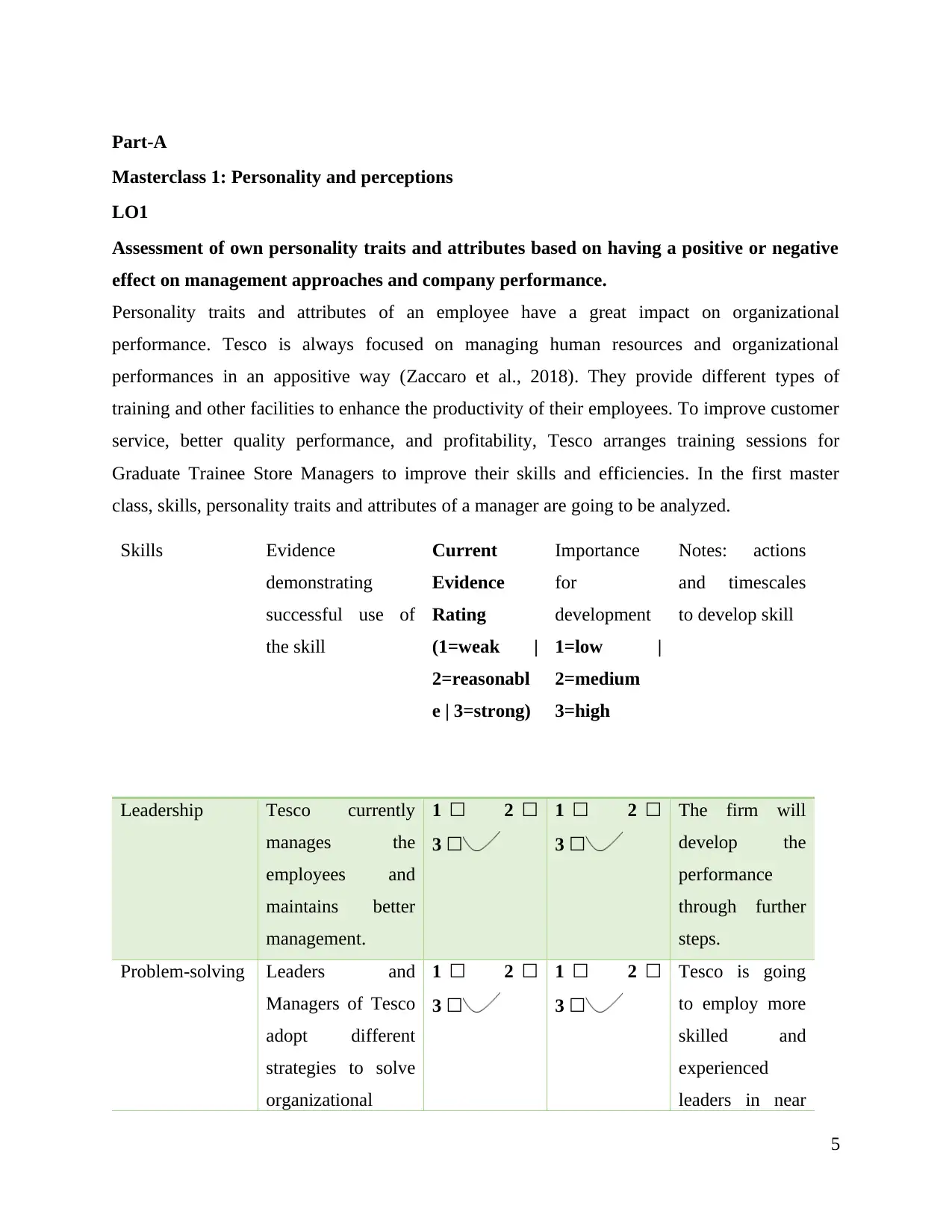
Part-A
Masterclass 1: Personality and perceptions
LO1
Assessment of own personality traits and attributes based on having a positive or negative
effect on management approaches and company performance.
Personality traits and attributes of an employee have a great impact on organizational
performance. Tesco is always focused on managing human resources and organizational
performances in an appositive way (Zaccaro et al., 2018). They provide different types of
training and other facilities to enhance the productivity of their employees. To improve customer
service, better quality performance, and profitability, Tesco arranges training sessions for
Graduate Trainee Store Managers to improve their skills and efficiencies. In the first master
class, skills, personality traits and attributes of a manager are going to be analyzed.
Skills Evidence
demonstrating
successful use of
the skill
Current
Evidence
Rating
(1=weak |
2=reasonabl
e | 3=strong)
Importance
for
development
1=low |
2=medium
3=high
Notes: actions
and timescales
to develop skill
Leadership Tesco currently
manages the
employees and
maintains better
management.
1 ☐ 2 ☐
3 ☐
1 ☐ 2 ☐
3 ☐
The firm will
develop the
performance
through further
steps.
Problem-solving Leaders and
Managers of Tesco
adopt different
strategies to solve
organizational
1 ☐ 2 ☐
3 ☐
1 ☐ 2 ☐
3 ☐
Tesco is going
to employ more
skilled and
experienced
leaders in near
5
Masterclass 1: Personality and perceptions
LO1
Assessment of own personality traits and attributes based on having a positive or negative
effect on management approaches and company performance.
Personality traits and attributes of an employee have a great impact on organizational
performance. Tesco is always focused on managing human resources and organizational
performances in an appositive way (Zaccaro et al., 2018). They provide different types of
training and other facilities to enhance the productivity of their employees. To improve customer
service, better quality performance, and profitability, Tesco arranges training sessions for
Graduate Trainee Store Managers to improve their skills and efficiencies. In the first master
class, skills, personality traits and attributes of a manager are going to be analyzed.
Skills Evidence
demonstrating
successful use of
the skill
Current
Evidence
Rating
(1=weak |
2=reasonabl
e | 3=strong)
Importance
for
development
1=low |
2=medium
3=high
Notes: actions
and timescales
to develop skill
Leadership Tesco currently
manages the
employees and
maintains better
management.
1 ☐ 2 ☐
3 ☐
1 ☐ 2 ☐
3 ☐
The firm will
develop the
performance
through further
steps.
Problem-solving Leaders and
Managers of Tesco
adopt different
strategies to solve
organizational
1 ☐ 2 ☐
3 ☐
1 ☐ 2 ☐
3 ☐
Tesco is going
to employ more
skilled and
experienced
leaders in near
5
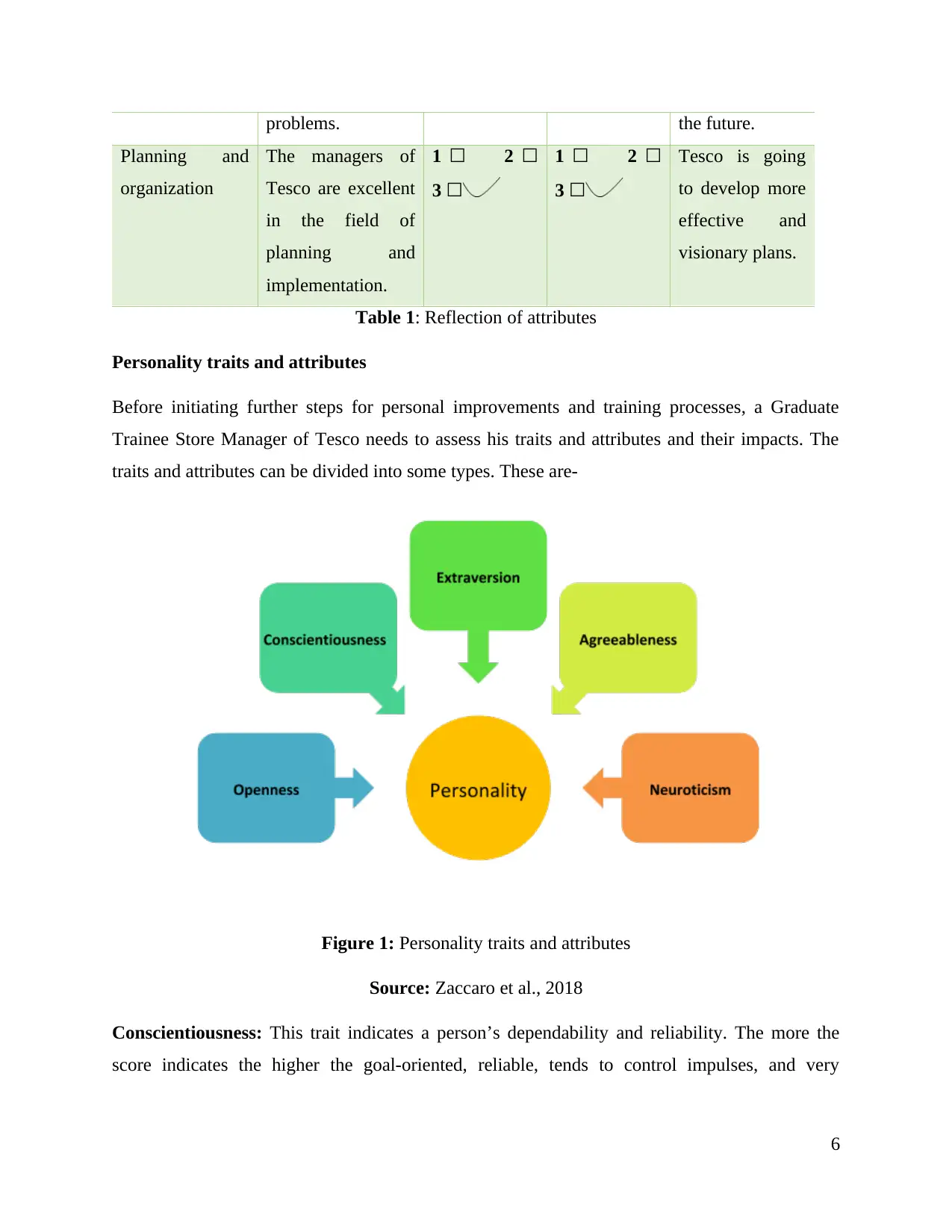
problems. the future.
Planning and
organization
The managers of
Tesco are excellent
in the field of
planning and
implementation.
1 ☐ 2 ☐
3 ☐
1 ☐ 2 ☐
3 ☐
Tesco is going
to develop more
effective and
visionary plans.
Table 1: Reflection of attributes
Personality traits and attributes
Before initiating further steps for personal improvements and training processes, a Graduate
Trainee Store Manager of Tesco needs to assess his traits and attributes and their impacts. The
traits and attributes can be divided into some types. These are-
Figure 1: Personality traits and attributes
Source: Zaccaro et al., 2018
Conscientiousness: This trait indicates a person’s dependability and reliability. The more the
score indicates the higher the goal-oriented, reliable, tends to control impulses, and very
6
Planning and
organization
The managers of
Tesco are excellent
in the field of
planning and
implementation.
1 ☐ 2 ☐
3 ☐
1 ☐ 2 ☐
3 ☐
Tesco is going
to develop more
effective and
visionary plans.
Table 1: Reflection of attributes
Personality traits and attributes
Before initiating further steps for personal improvements and training processes, a Graduate
Trainee Store Manager of Tesco needs to assess his traits and attributes and their impacts. The
traits and attributes can be divided into some types. These are-
Figure 1: Personality traits and attributes
Source: Zaccaro et al., 2018
Conscientiousness: This trait indicates a person’s dependability and reliability. The more the
score indicates the higher the goal-oriented, reliable, tends to control impulses, and very
6
⊘ This is a preview!⊘
Do you want full access?
Subscribe today to unlock all pages.

Trusted by 1+ million students worldwide
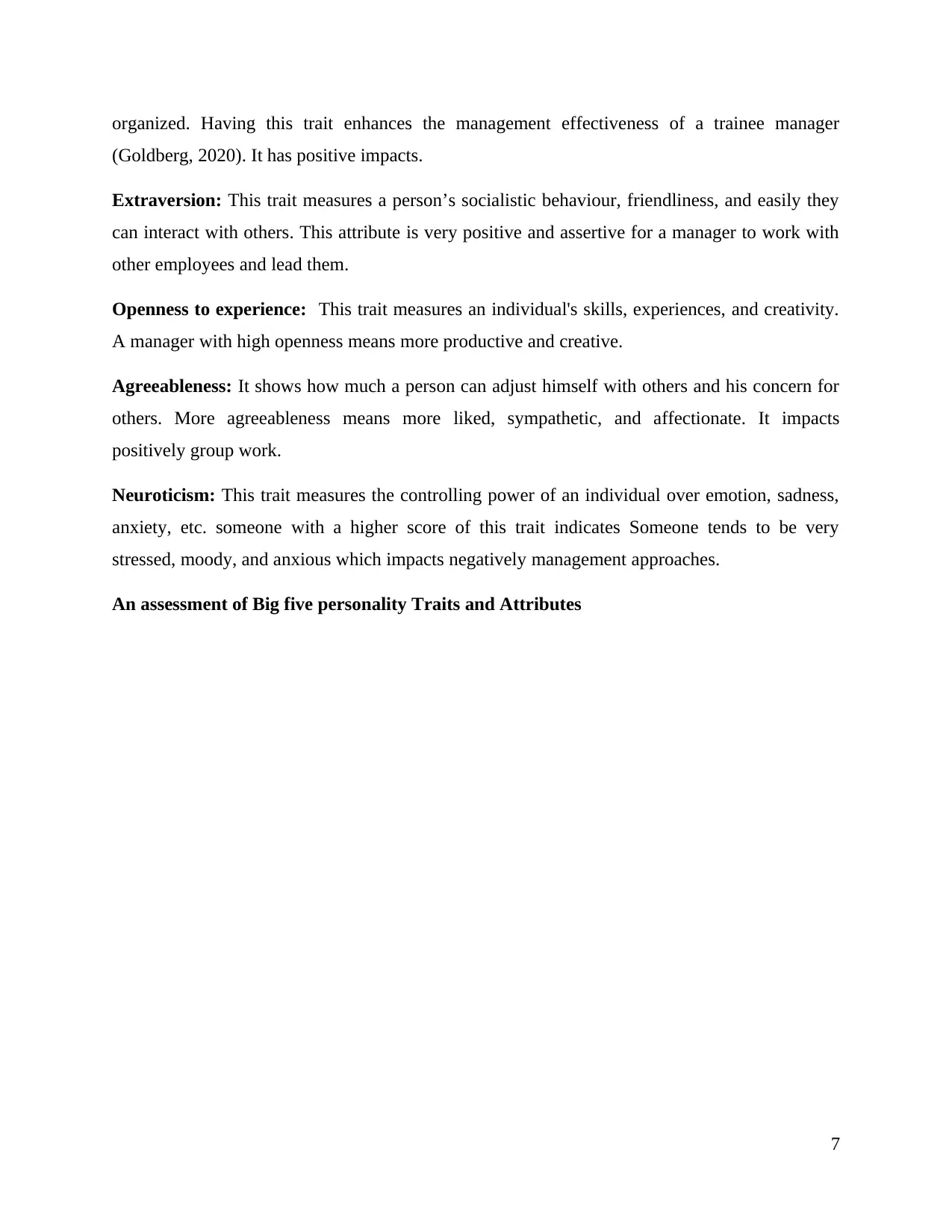
organized. Having this trait enhances the management effectiveness of a trainee manager
(Goldberg, 2020). It has positive impacts.
Extraversion: This trait measures a person’s socialistic behaviour, friendliness, and easily they
can interact with others. This attribute is very positive and assertive for a manager to work with
other employees and lead them.
Openness to experience: This trait measures an individual's skills, experiences, and creativity.
A manager with high openness means more productive and creative.
Agreeableness: It shows how much a person can adjust himself with others and his concern for
others. More agreeableness means more liked, sympathetic, and affectionate. It impacts
positively group work.
Neuroticism: This trait measures the controlling power of an individual over emotion, sadness,
anxiety, etc. someone with a higher score of this trait indicates Someone tends to be very
stressed, moody, and anxious which impacts negatively management approaches.
An assessment of Big five personality Traits and Attributes
7
(Goldberg, 2020). It has positive impacts.
Extraversion: This trait measures a person’s socialistic behaviour, friendliness, and easily they
can interact with others. This attribute is very positive and assertive for a manager to work with
other employees and lead them.
Openness to experience: This trait measures an individual's skills, experiences, and creativity.
A manager with high openness means more productive and creative.
Agreeableness: It shows how much a person can adjust himself with others and his concern for
others. More agreeableness means more liked, sympathetic, and affectionate. It impacts
positively group work.
Neuroticism: This trait measures the controlling power of an individual over emotion, sadness,
anxiety, etc. someone with a higher score of this trait indicates Someone tends to be very
stressed, moody, and anxious which impacts negatively management approaches.
An assessment of Big five personality Traits and Attributes
7
Paraphrase This Document
Need a fresh take? Get an instant paraphrase of this document with our AI Paraphraser
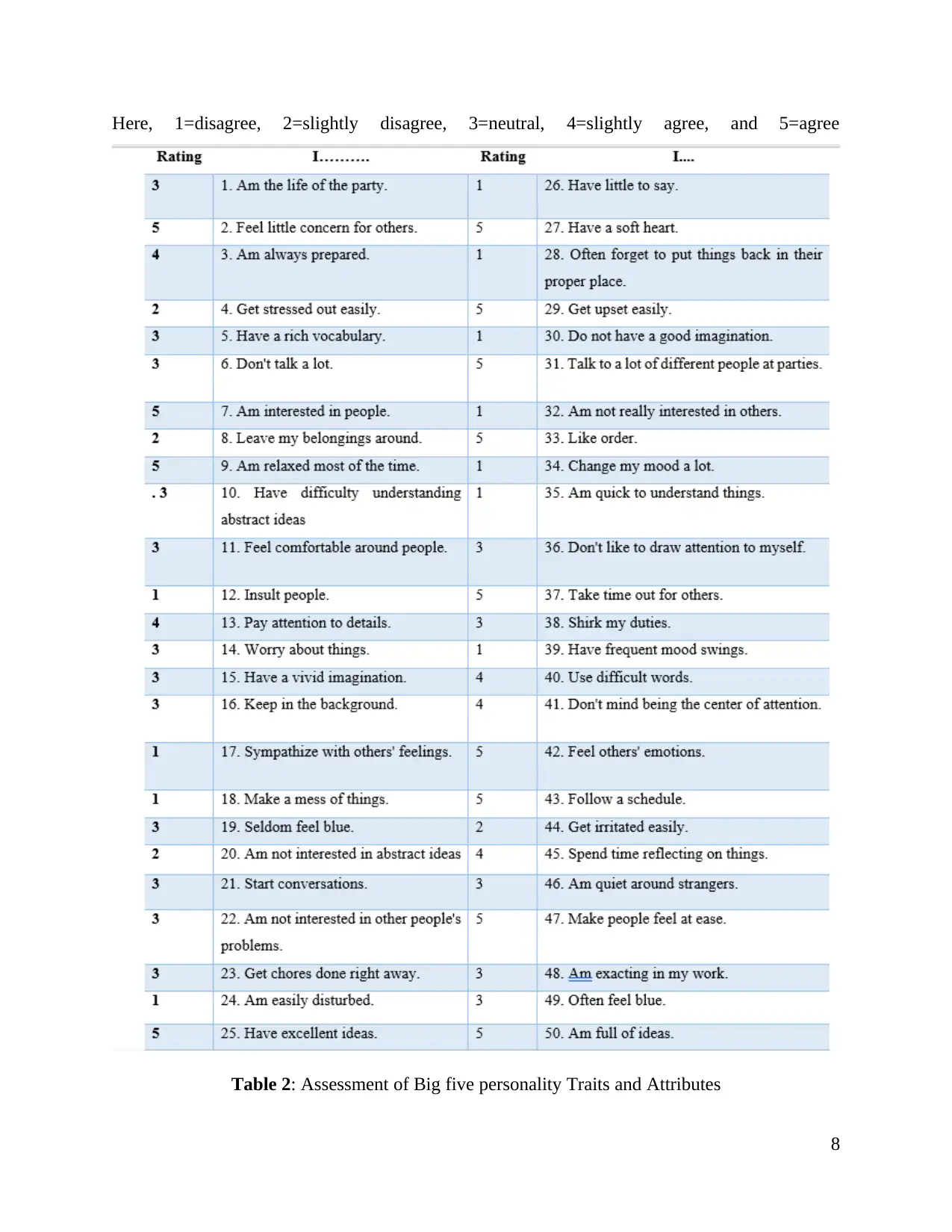
Here, 1=disagree, 2=slightly disagree, 3=neutral, 4=slightly agree, and 5=agree
Table 2: Assessment of Big five personality Traits and Attributes
8
Table 2: Assessment of Big five personality Traits and Attributes
8
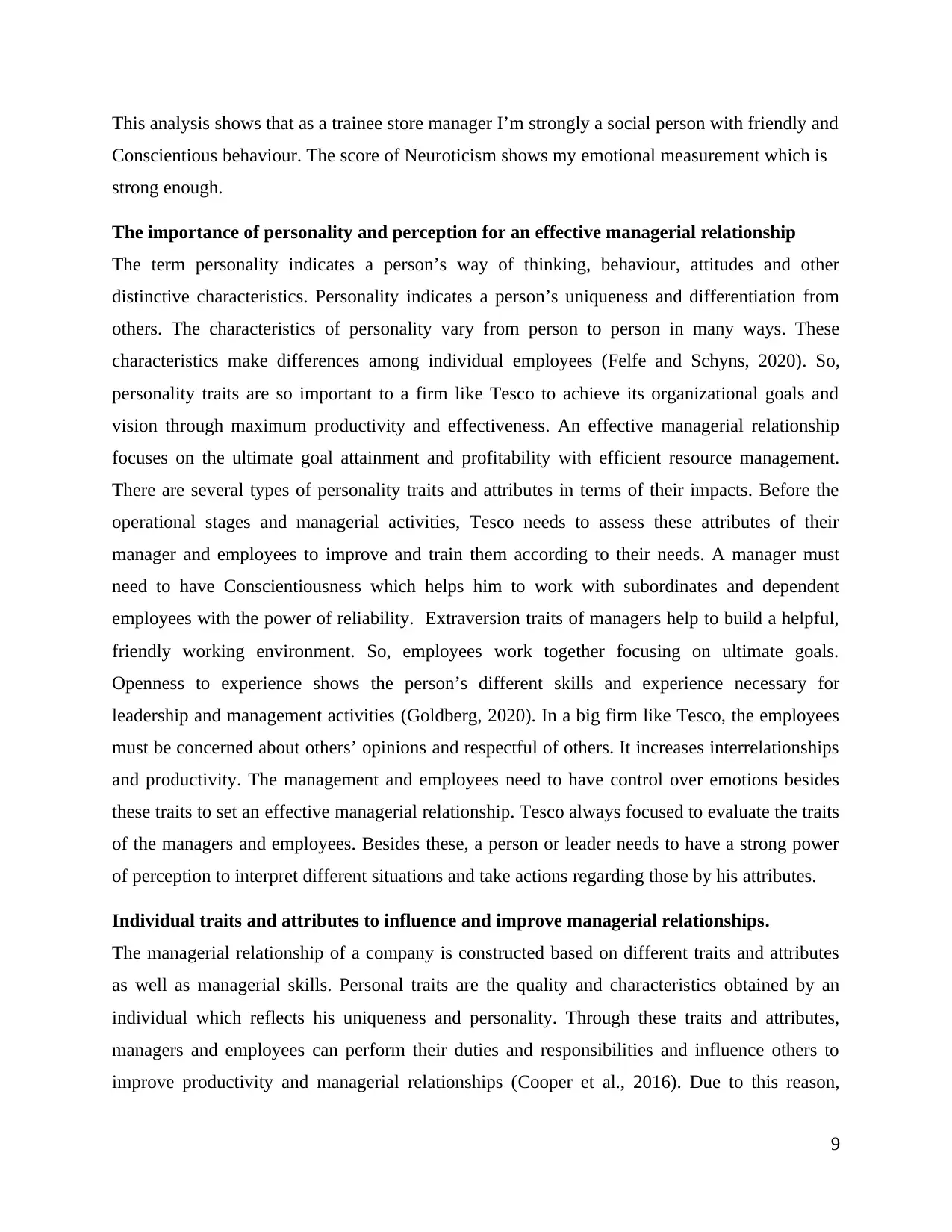
This analysis shows that as a trainee store manager I’m strongly a social person with friendly and
Conscientious behaviour. The score of Neuroticism shows my emotional measurement which is
strong enough.
The importance of personality and perception for an effective managerial relationship
The term personality indicates a person’s way of thinking, behaviour, attitudes and other
distinctive characteristics. Personality indicates a person’s uniqueness and differentiation from
others. The characteristics of personality vary from person to person in many ways. These
characteristics make differences among individual employees (Felfe and Schyns, 2020). So,
personality traits are so important to a firm like Tesco to achieve its organizational goals and
vision through maximum productivity and effectiveness. An effective managerial relationship
focuses on the ultimate goal attainment and profitability with efficient resource management.
There are several types of personality traits and attributes in terms of their impacts. Before the
operational stages and managerial activities, Tesco needs to assess these attributes of their
manager and employees to improve and train them according to their needs. A manager must
need to have Conscientiousness which helps him to work with subordinates and dependent
employees with the power of reliability. Extraversion traits of managers help to build a helpful,
friendly working environment. So, employees work together focusing on ultimate goals.
Openness to experience shows the person’s different skills and experience necessary for
leadership and management activities (Goldberg, 2020). In a big firm like Tesco, the employees
must be concerned about others’ opinions and respectful of others. It increases interrelationships
and productivity. The management and employees need to have control over emotions besides
these traits to set an effective managerial relationship. Tesco always focused to evaluate the traits
of the managers and employees. Besides these, a person or leader needs to have a strong power
of perception to interpret different situations and take actions regarding those by his attributes.
Individual traits and attributes to influence and improve managerial relationships.
The managerial relationship of a company is constructed based on different traits and attributes
as well as managerial skills. Personal traits are the quality and characteristics obtained by an
individual which reflects his uniqueness and personality. Through these traits and attributes,
managers and employees can perform their duties and responsibilities and influence others to
improve productivity and managerial relationships (Cooper et al., 2016). Due to this reason,
9
Conscientious behaviour. The score of Neuroticism shows my emotional measurement which is
strong enough.
The importance of personality and perception for an effective managerial relationship
The term personality indicates a person’s way of thinking, behaviour, attitudes and other
distinctive characteristics. Personality indicates a person’s uniqueness and differentiation from
others. The characteristics of personality vary from person to person in many ways. These
characteristics make differences among individual employees (Felfe and Schyns, 2020). So,
personality traits are so important to a firm like Tesco to achieve its organizational goals and
vision through maximum productivity and effectiveness. An effective managerial relationship
focuses on the ultimate goal attainment and profitability with efficient resource management.
There are several types of personality traits and attributes in terms of their impacts. Before the
operational stages and managerial activities, Tesco needs to assess these attributes of their
manager and employees to improve and train them according to their needs. A manager must
need to have Conscientiousness which helps him to work with subordinates and dependent
employees with the power of reliability. Extraversion traits of managers help to build a helpful,
friendly working environment. So, employees work together focusing on ultimate goals.
Openness to experience shows the person’s different skills and experience necessary for
leadership and management activities (Goldberg, 2020). In a big firm like Tesco, the employees
must be concerned about others’ opinions and respectful of others. It increases interrelationships
and productivity. The management and employees need to have control over emotions besides
these traits to set an effective managerial relationship. Tesco always focused to evaluate the traits
of the managers and employees. Besides these, a person or leader needs to have a strong power
of perception to interpret different situations and take actions regarding those by his attributes.
Individual traits and attributes to influence and improve managerial relationships.
The managerial relationship of a company is constructed based on different traits and attributes
as well as managerial skills. Personal traits are the quality and characteristics obtained by an
individual which reflects his uniqueness and personality. Through these traits and attributes,
managers and employees can perform their duties and responsibilities and influence others to
improve productivity and managerial relationships (Cooper et al., 2016). Due to this reason,
9
⊘ This is a preview!⊘
Do you want full access?
Subscribe today to unlock all pages.

Trusted by 1+ million students worldwide
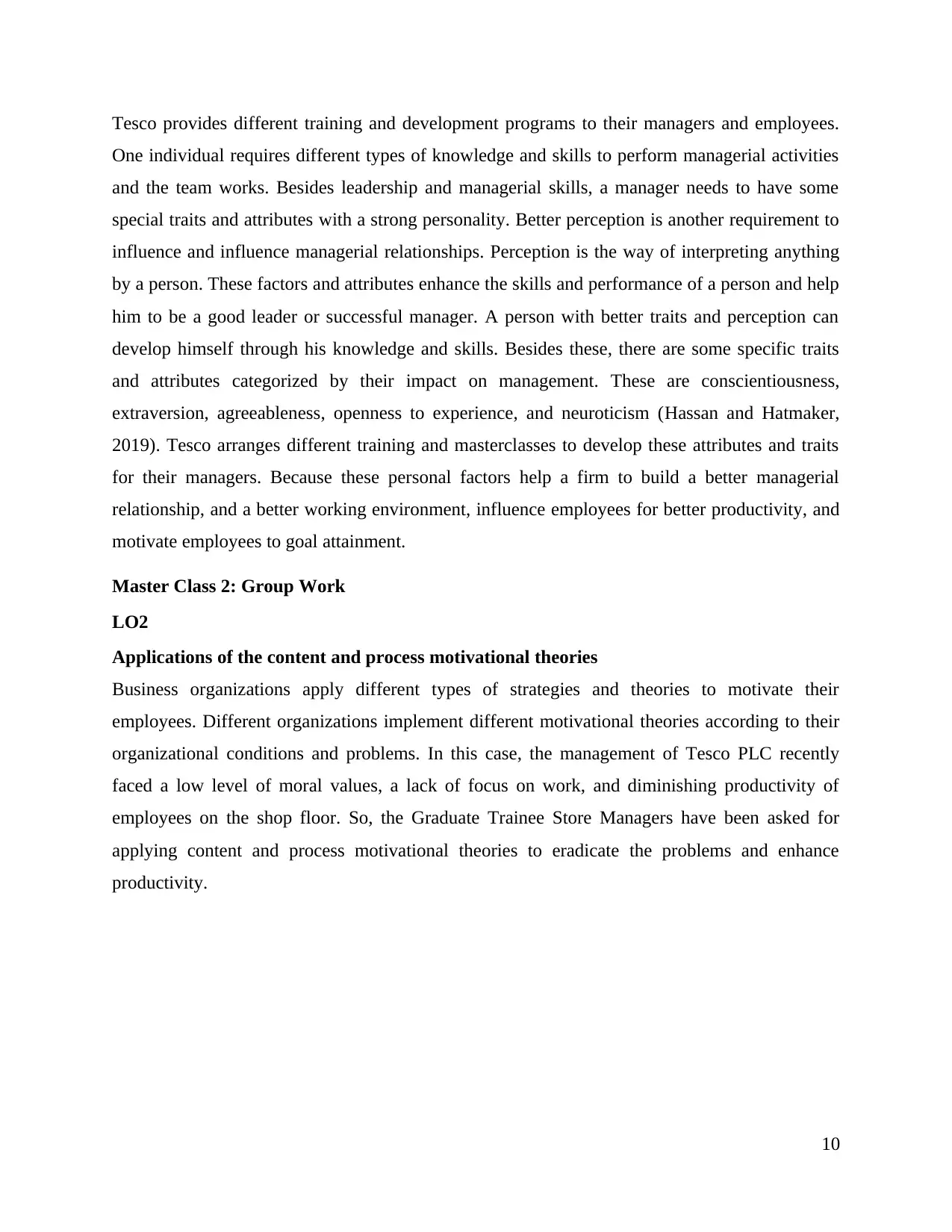
Tesco provides different training and development programs to their managers and employees.
One individual requires different types of knowledge and skills to perform managerial activities
and the team works. Besides leadership and managerial skills, a manager needs to have some
special traits and attributes with a strong personality. Better perception is another requirement to
influence and influence managerial relationships. Perception is the way of interpreting anything
by a person. These factors and attributes enhance the skills and performance of a person and help
him to be a good leader or successful manager. A person with better traits and perception can
develop himself through his knowledge and skills. Besides these, there are some specific traits
and attributes categorized by their impact on management. These are conscientiousness,
extraversion, agreeableness, openness to experience, and neuroticism (Hassan and Hatmaker,
2019). Tesco arranges different training and masterclasses to develop these attributes and traits
for their managers. Because these personal factors help a firm to build a better managerial
relationship, and a better working environment, influence employees for better productivity, and
motivate employees to goal attainment.
Master Class 2: Group Work
LO2
Applications of the content and process motivational theories
Business organizations apply different types of strategies and theories to motivate their
employees. Different organizations implement different motivational theories according to their
organizational conditions and problems. In this case, the management of Tesco PLC recently
faced a low level of moral values, a lack of focus on work, and diminishing productivity of
employees on the shop floor. So, the Graduate Trainee Store Managers have been asked for
applying content and process motivational theories to eradicate the problems and enhance
productivity.
10
One individual requires different types of knowledge and skills to perform managerial activities
and the team works. Besides leadership and managerial skills, a manager needs to have some
special traits and attributes with a strong personality. Better perception is another requirement to
influence and influence managerial relationships. Perception is the way of interpreting anything
by a person. These factors and attributes enhance the skills and performance of a person and help
him to be a good leader or successful manager. A person with better traits and perception can
develop himself through his knowledge and skills. Besides these, there are some specific traits
and attributes categorized by their impact on management. These are conscientiousness,
extraversion, agreeableness, openness to experience, and neuroticism (Hassan and Hatmaker,
2019). Tesco arranges different training and masterclasses to develop these attributes and traits
for their managers. Because these personal factors help a firm to build a better managerial
relationship, and a better working environment, influence employees for better productivity, and
motivate employees to goal attainment.
Master Class 2: Group Work
LO2
Applications of the content and process motivational theories
Business organizations apply different types of strategies and theories to motivate their
employees. Different organizations implement different motivational theories according to their
organizational conditions and problems. In this case, the management of Tesco PLC recently
faced a low level of moral values, a lack of focus on work, and diminishing productivity of
employees on the shop floor. So, the Graduate Trainee Store Managers have been asked for
applying content and process motivational theories to eradicate the problems and enhance
productivity.
10
Paraphrase This Document
Need a fresh take? Get an instant paraphrase of this document with our AI Paraphraser
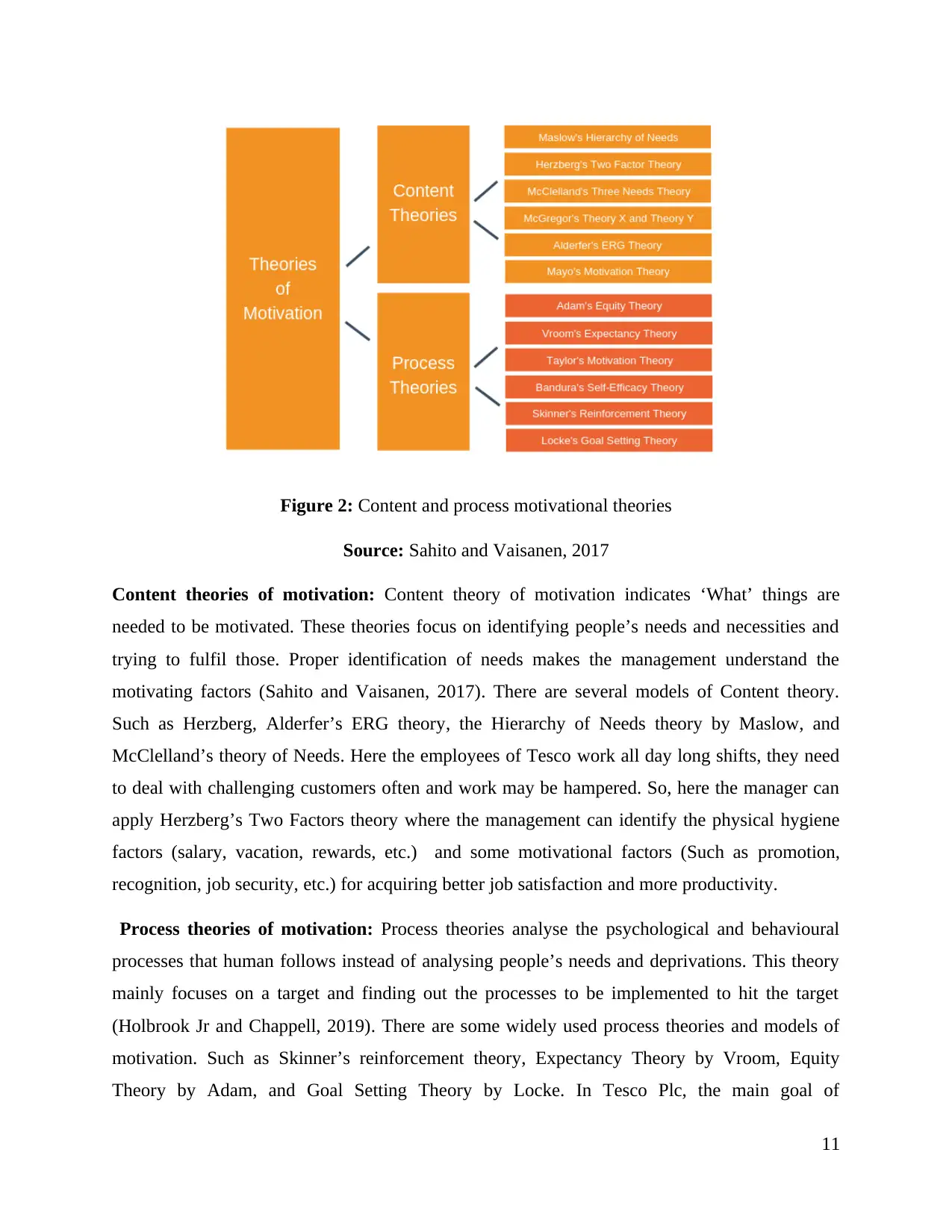
Figure 2: Content and process motivational theories
Source: Sahito and Vaisanen, 2017
Content theories of motivation: Content theory of motivation indicates ‘What’ things are
needed to be motivated. These theories focus on identifying people’s needs and necessities and
trying to fulfil those. Proper identification of needs makes the management understand the
motivating factors (Sahito and Vaisanen, 2017). There are several models of Content theory.
Such as Herzberg, Alderfer’s ERG theory, the Hierarchy of Needs theory by Maslow, and
McClelland’s theory of Needs. Here the employees of Tesco work all day long shifts, they need
to deal with challenging customers often and work may be hampered. So, here the manager can
apply Herzberg’s Two Factors theory where the management can identify the physical hygiene
factors (salary, vacation, rewards, etc.) and some motivational factors (Such as promotion,
recognition, job security, etc.) for acquiring better job satisfaction and more productivity.
Process theories of motivation: Process theories analyse the psychological and behavioural
processes that human follows instead of analysing people’s needs and deprivations. This theory
mainly focuses on a target and finding out the processes to be implemented to hit the target
(Holbrook Jr and Chappell, 2019). There are some widely used process theories and models of
motivation. Such as Skinner’s reinforcement theory, Expectancy Theory by Vroom, Equity
Theory by Adam, and Goal Setting Theory by Locke. In Tesco Plc, the main goal of
11
Source: Sahito and Vaisanen, 2017
Content theories of motivation: Content theory of motivation indicates ‘What’ things are
needed to be motivated. These theories focus on identifying people’s needs and necessities and
trying to fulfil those. Proper identification of needs makes the management understand the
motivating factors (Sahito and Vaisanen, 2017). There are several models of Content theory.
Such as Herzberg, Alderfer’s ERG theory, the Hierarchy of Needs theory by Maslow, and
McClelland’s theory of Needs. Here the employees of Tesco work all day long shifts, they need
to deal with challenging customers often and work may be hampered. So, here the manager can
apply Herzberg’s Two Factors theory where the management can identify the physical hygiene
factors (salary, vacation, rewards, etc.) and some motivational factors (Such as promotion,
recognition, job security, etc.) for acquiring better job satisfaction and more productivity.
Process theories of motivation: Process theories analyse the psychological and behavioural
processes that human follows instead of analysing people’s needs and deprivations. This theory
mainly focuses on a target and finding out the processes to be implemented to hit the target
(Holbrook Jr and Chappell, 2019). There are some widely used process theories and models of
motivation. Such as Skinner’s reinforcement theory, Expectancy Theory by Vroom, Equity
Theory by Adam, and Goal Setting Theory by Locke. In Tesco Plc, the main goal of
11
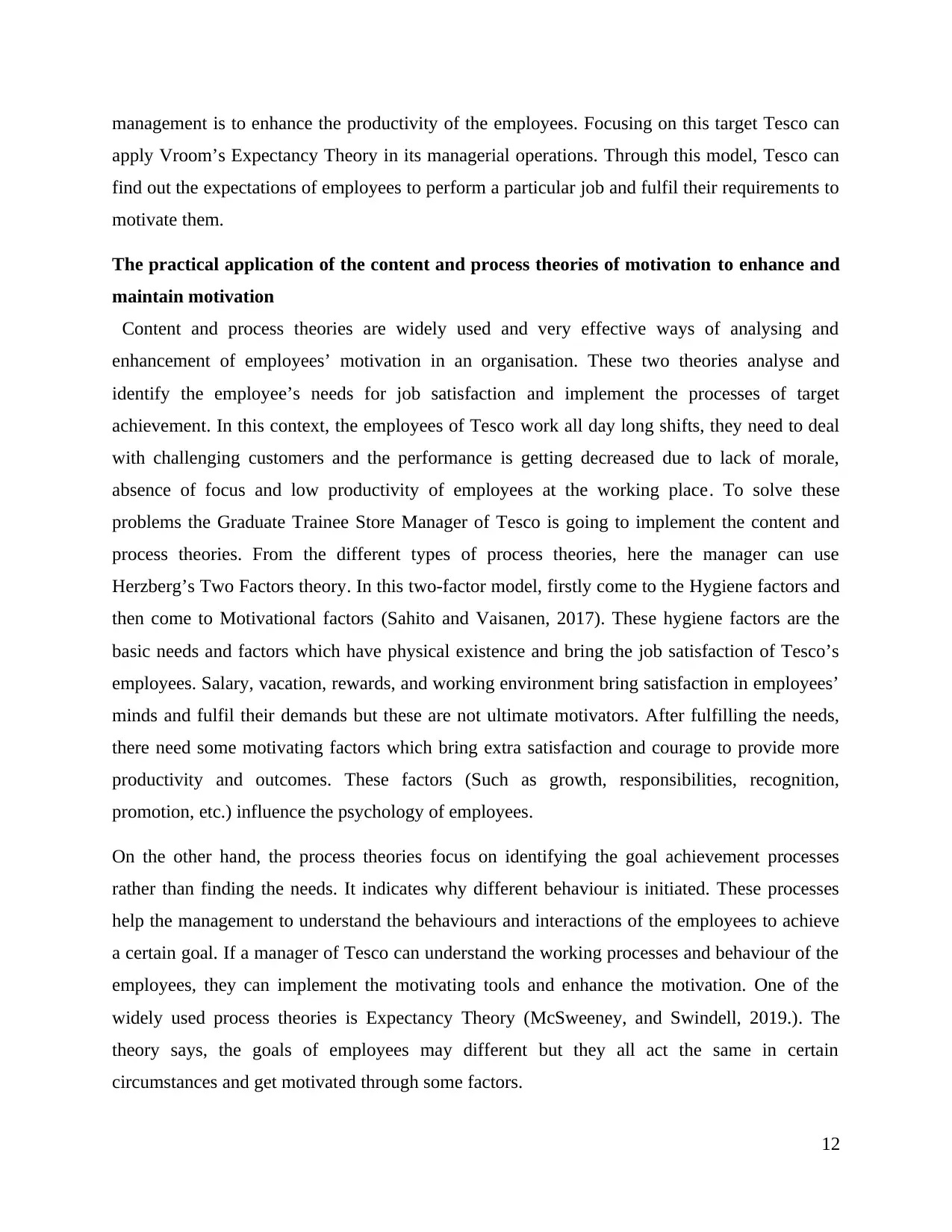
management is to enhance the productivity of the employees. Focusing on this target Tesco can
apply Vroom’s Expectancy Theory in its managerial operations. Through this model, Tesco can
find out the expectations of employees to perform a particular job and fulfil their requirements to
motivate them.
The practical application of the content and process theories of motivation to enhance and
maintain motivation
Content and process theories are widely used and very effective ways of analysing and
enhancement of employees’ motivation in an organisation. These two theories analyse and
identify the employee’s needs for job satisfaction and implement the processes of target
achievement. In this context, the employees of Tesco work all day long shifts, they need to deal
with challenging customers and the performance is getting decreased due to lack of morale,
absence of focus and low productivity of employees at the working place. To solve these
problems the Graduate Trainee Store Manager of Tesco is going to implement the content and
process theories. From the different types of process theories, here the manager can use
Herzberg’s Two Factors theory. In this two-factor model, firstly come to the Hygiene factors and
then come to Motivational factors (Sahito and Vaisanen, 2017). These hygiene factors are the
basic needs and factors which have physical existence and bring the job satisfaction of Tesco’s
employees. Salary, vacation, rewards, and working environment bring satisfaction in employees’
minds and fulfil their demands but these are not ultimate motivators. After fulfilling the needs,
there need some motivating factors which bring extra satisfaction and courage to provide more
productivity and outcomes. These factors (Such as growth, responsibilities, recognition,
promotion, etc.) influence the psychology of employees.
On the other hand, the process theories focus on identifying the goal achievement processes
rather than finding the needs. It indicates why different behaviour is initiated. These processes
help the management to understand the behaviours and interactions of the employees to achieve
a certain goal. If a manager of Tesco can understand the working processes and behaviour of the
employees, they can implement the motivating tools and enhance the motivation. One of the
widely used process theories is Expectancy Theory (McSweeney, and Swindell, 2019.). The
theory says, the goals of employees may different but they all act the same in certain
circumstances and get motivated through some factors.
12
apply Vroom’s Expectancy Theory in its managerial operations. Through this model, Tesco can
find out the expectations of employees to perform a particular job and fulfil their requirements to
motivate them.
The practical application of the content and process theories of motivation to enhance and
maintain motivation
Content and process theories are widely used and very effective ways of analysing and
enhancement of employees’ motivation in an organisation. These two theories analyse and
identify the employee’s needs for job satisfaction and implement the processes of target
achievement. In this context, the employees of Tesco work all day long shifts, they need to deal
with challenging customers and the performance is getting decreased due to lack of morale,
absence of focus and low productivity of employees at the working place. To solve these
problems the Graduate Trainee Store Manager of Tesco is going to implement the content and
process theories. From the different types of process theories, here the manager can use
Herzberg’s Two Factors theory. In this two-factor model, firstly come to the Hygiene factors and
then come to Motivational factors (Sahito and Vaisanen, 2017). These hygiene factors are the
basic needs and factors which have physical existence and bring the job satisfaction of Tesco’s
employees. Salary, vacation, rewards, and working environment bring satisfaction in employees’
minds and fulfil their demands but these are not ultimate motivators. After fulfilling the needs,
there need some motivating factors which bring extra satisfaction and courage to provide more
productivity and outcomes. These factors (Such as growth, responsibilities, recognition,
promotion, etc.) influence the psychology of employees.
On the other hand, the process theories focus on identifying the goal achievement processes
rather than finding the needs. It indicates why different behaviour is initiated. These processes
help the management to understand the behaviours and interactions of the employees to achieve
a certain goal. If a manager of Tesco can understand the working processes and behaviour of the
employees, they can implement the motivating tools and enhance the motivation. One of the
widely used process theories is Expectancy Theory (McSweeney, and Swindell, 2019.). The
theory says, the goals of employees may different but they all act the same in certain
circumstances and get motivated through some factors.
12
⊘ This is a preview!⊘
Do you want full access?
Subscribe today to unlock all pages.

Trusted by 1+ million students worldwide
1 out of 32
Related Documents
Your All-in-One AI-Powered Toolkit for Academic Success.
+13062052269
info@desklib.com
Available 24*7 on WhatsApp / Email
![[object Object]](/_next/static/media/star-bottom.7253800d.svg)
Unlock your academic potential
Copyright © 2020–2025 A2Z Services. All Rights Reserved. Developed and managed by ZUCOL.




